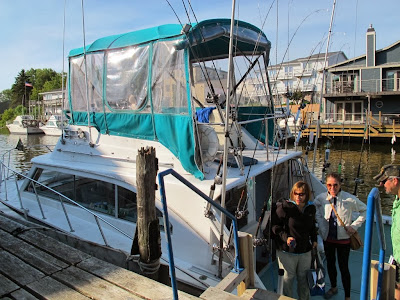 |
| Founder's Brewery sign. |
by Pam O'Meara
Lilie Newspaper
I wonder if my grandparents are rolling over in their graves since
their hometown of Grand Rapids, Mich., was recently named “Beer City
U.S.A.” and one of the “Top 10 Vacation Cities for Beer Lovers.”
The city recently celebrated with “Cool Brews/Hot Eats,” a 13-day festival of food and beer tastings.
I was born in Grand Rapids and visited annually for most of my life,
but always thought of the city’s population as Protestant teetotalers.
My Dutch grandparents were members of the conservative Christian
Reformed Church, and the city is a center of Christian book publishing.
It’s ringed by a number of church-related colleges.
Best brews - who knew?
 |
| Inside of Founder's. |
So I was surprised to hear that in 2012, Grand Rapids tied with
Asheville, NC, for the Beer City title thanks to its high-quality craft
breweries. The “brew review” site Ratebeer.com, which boasts “hundreds
of thousands of members from more than 100 countries” gave the
second-largest city in Michigan the nod.
On a recent trip to see my mother and sister, I took a craft beer
tour with a friend. Our first stop was Founders Brewing Co., where Janet
and I shared a mug of rich, creamy oatmeal stout, and polished off a
bowl of chips and beer cheese dip in the tap room before watching the
whole beer making process.
 |
| Founder's beer-cheese dip. |
Founders is the largest brewery in Grand Rapids and distributes its
craft beer in 23 states, including Minnesota. Founders co-owner Dave
Engbers said his place is not only the third-highest rated brewery in
the world, according to Ratebeer.com, but is also family-friendly up
until 9 p.m. After 16 years in operation, Founders now serves -- and
employs -- many of the kids who used to come for the free peanuts during
family hours.
When I was a child, Grand Rapids’ John Ball Park and Zoo was a
favorite destination. So when I saw that the Grand Rapids Brewery has a
brown ale named John Ball, I had to sample the toasty, nutty brew. Ditto
with Silver Foam, a light-tasting lager that was a staple in 1912 and
was reintroduced on its centennial. Memorabilia from the early days
decorate the walls.
 |
| Founder's Beer tanks. |
Next, we checked out HopCat. With 48 taps and 150 bottles on hand,
including Michigan specialties and global offerings, HopCat was named
the No. 1 craft brew bar in the U. S. by brewrate.com.
Then it was on to the whimsically-named Brewery Vivant, whose bar is
housed in an old funeral chapel, complete with arched beams and
stained-glass windows. Servers work behind a bar located where the altar
would have been.
Take two pints and call me in the morning
It turns out Grand Rapids came by its breweries like many other U.S.
towns in the 1800s. Beer-drinking was a tradition brought from Europe,
and it was often served to men, women and children with meals. The first
brewer in town was Englishman John Pannell in 1836. A few years later,
German Christoph Kusterer set up shop.
 |
| GR Beer Week sign. |
Kusterer and others advertised their beer as a healthy family drink,
which in a way it was, since fresh water from rivers or lakes could be
polluted. According to at least anecdotal observation, the number of
people with malaria-related shaking ague in 1847 greatly diminished with
increased beer drinking.
Many more breweries were established in the next few decades until in
1892, six major ones consolidated into the Grand Rapids Brewing Company
to be more competitive. The company began making Silver Foam beer,
which became popular around the country.
Beer production flourished in Grand Rapids when my grandparents were
young adults. Then in 1918, two years before nationwide Prohibition was
passed, Michigan went dry, and 160 bars closed.
However, home brewing proliferated behind closed doors until Michigan
became the first state in 1933 to ratify the 21st Amendment repealing
prohibition.
Legal again
Though several downtown breweries opened again, they only lasted a
couple of decades before succumbing to competition from huge breweries.
 |
| Grand Rapids brewery sign. |
In 1997, a few friends from Holland Michigan’s Hope College, which
was established by the Reformed Church of America, ended a 46-year beer
drought downtown. With the opening of Founders, Engbers and co-owner
Mike Stevens brought back the old brewing traditions. Others soon
followed.
“All the breweries of the Hope group are pretty nice beers due to the
high standard set by Bell’s Brewery in Kalamazoo,” Engbers says.
Janet suggests this is part of the same entrepreneurial spirit that
brought considerable downtown development by wealthy local
philanthropists including the Amway founders, the Meijers family and
Steelcase furniture company owners the last two decades. The new crop of
entrepreneurs includes a younger generation interested in dining out
and drinking craft beer.
 |
| Old Mortuary. |
“Beer is a social beverage. You can drink responsibly and have a good
time,” Engbers adds. In fact, Founders throws a beer fest in June when
the street in front is closed off for a celebration of beer and music – a
thank you to the city for its support.
Grand Rapids is no longer as conservative as it used to be, Janet tells me.
But I still wonder what my grandparents would think.
Reprinted with permission from Lillie Suburban Newspapers
 |
| Silver Foam beer. |



























